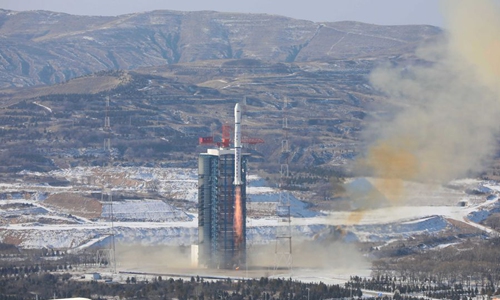HOME >> SCI-TECH
Ethiopia hails Chinese-backed satellite launch
Source:Xinhua Published: 2019/12/22 12:31:19

Ethiopia's first-ever satellite, known as ETRSS-1, is launched on a Long March-4B carrier rocket at Taiyuan Satellite Launch Center in north China's Shanxi Province on Dec. 20, 2019. (Photo by Zheng Taotao/Xinhua)
Beza Tesfaye, General Manager of Ethiopia Space Science Society (ESSS) feels satisfied that her country on Friday successful launched its first ever satellite to space through the support of China.
Ethiopia has developed the country's first-ever satellite, known as ETRSS-1, through support from the Chinese government.
Tesfaye who was one of the founders of the ESSS, a non-governmental institution dedicated to Ethiopia's space science technology development, said when her organization first started work in 2004, many fellow Ethiopians thought her work was crazy. "When ESSS first started work in 2004, many Ethiopians thought we were crazy and that Space science was a preserve of developed nations."
"Fifteen years later, attitudes both at the government level and the public levels have changed with many believing space science to be an integral part of Ethiopia's economic development endeavors," Tsefaye told Xinhua.
ESSS had largely been working in the dark in its first years until 2012, when two major events, helped the east African country's space science sector make a significant leap.
The first was the agreement Ethiopia Space Science Society signed with the China National Space Administration to boost Ethiopia's space science exploration capacity.
The second was a 5-million U.S. dollars donation by Ethiopian born Saudi tycoon Sheikh Mohammed Hussein Al-Amoudi to ESSS that helped build Ethiopia's first space observatory facility in Entoto, on the outskirts of Addis Ababa.
The satellite, which was successfully launched from China on Friday, will have its command and control center in Ethiopia at Entoto space observatory facility -- East Africa's only space observatory facility located on the 3,200-meter hills of Entoto.
"The partnership with China's national space agency has helped scores of our staff get training in advanced space science as well as helped Ethiopian space scientists visit China's Space Science facilities," said Tesfaye.
Tesfaye further said China which currently is one of only nine countries in the world self-sufficient in orbital launch capability and has been generous in availing its space science technology know-how and facilities to Ethiopia.
"Ethiopia will learn a lot from the launch of its first Chinese-backed space satellite," Tesfaye told Xinhua.
CHINESE ASSISTACE A GAME CHANGER IN ETHIOPIAN SPACE SCIENCE SECTOR
The Ethiopia Minister of Innovation and Technology Getahun Mekuria, a space science enthusiast, told Xinhua recently China's assistance in Ethiopia's space science sector is a game changer to the east African country's space science sector.
"Ethiopia and China have strong multifaceted ties,"said Mekuria, citing Ethiopia's first space satellite launch under the support of China on Dec. 20.
"Already, China has helped train 20 Ethiopian space engineers both in China and at home using experienced Chinese personnel. These Ethiopian engineers are expected to play a key part in operating Ethiopia's first space satellite," Mekuria told Xinhua.
A large Ethiopian delegation composed of senior Ethiopian government officials and media personalities attended the launch of Ethiopia's first space satellite in China.
"This new Chinese-backed satellite will help Ethiopia save much-needed foreign currency that it currently spends to get information from foreign-owned satellites," Mekuria told Xinhua.
Once operational, the satellite is expected to save Ethiopia around 350 million birr (about 11 million U.S. dollars) annually it currently spends to receive information from satellites owned by other countries.
Ethiopia plans to use the ETRSS-1 space satellite for a range of activities, including agricultural transformation, forest resource monitoring, weather forecast, mining potential assessment, as well as infrastructure development and monitoring.
Posted in: AIR & SPACE